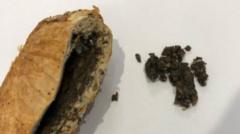The Supreme Court of Victoria has made public a series of compelling photographs and evidence in the notorious trial of 50-year-old Erin Patterson, who stands convicted of murdering three relatives with a deadly meal in the Victorian town of Morwell on July 29, 2023. Patterson was found guilty by a jury of three counts of murder, alongside an attempted murder charge concerning a fourth family member who survived the meal.
The trial, which drew national and international attention, unveiled the depths of Patterson’s alleged malice. It emerged that she purportedly foraged for lethal death cap mushrooms from locations nearby, all while attempting to erase incriminating evidence and misleading law enforcement. Tragically, Don and Gail Patterson, both aged 70, and Heather Wilkinson, 66, fell gravely ill post-meal and ultimately passed away within days. Ian Wilkinson, Heather's husband, endured weeks of hospitalization yet survived the deadly dish.
Patterson’s estranged spouse, Simon Patterson, opted out of attending the meal amid existing tension, citing personal discomfort. Following the jury's ruling, the court disclosed roughly 100 images submitted as evidence, including haunting photos of the leftover beef Wellington that were seized from Patterson’s residence and subsequently preserved to prevent contamination prior to scientific examination.
Examinations of the leftovers indicated their potential link to the highly toxic death cap mushrooms, notorious for causing the most fatalities among mushroom poisoning cases globally, as documented by Britannica. The mushrooms’ coloration can vary substantially, typically featuring caps in shades of greenish-yellow to brown or, though less commonly, white.
While Patterson claimed to have purchased dried mushrooms from an Asian grocery store in Melbourne, she faltered when pressed for specifics about the transaction, stating that the packaging was generic and she likely paid in cash. Meanwhile, detectives noted that images of death cap mushrooms had been circulated in local communities via iNaturalist, a plant identification platform, right before the incident.
Additionally, Patterson’s online search history revealed inquisitions regarding death cap sightings. Location data from her mobile phone indicated visits to spots where these dangerous mushrooms had been reported, including a purchase of a food dehydrator on her return. Forensic recovery of mobile images appeared to show the mushrooms on weighing scales, raising alarm over her actions.
Experts reiterated the peril posed by even microscopic quantities of death cap mushrooms, whose toxins resist all forms of cooking or preservation. In a twist of irony, after her hospital visit, Patterson disposed of a food dehydrator, later traced by police which matched the forensic evidence of poisonous mushroom residue.
Despite her claims of ignorance regarding the appliance, the discovery of an instruction manual and her previous posts bragging about using it on social media hinted at a different narrative. In security footage, Patterson was captured discarding the dehydrator days after serving the lethal meal.
The case, characterized by overwhelming evidence and accusations of a sinister motive, has captivated the public and left many questions lingering in its wake as it unfolds in the courts.
The trial, which drew national and international attention, unveiled the depths of Patterson’s alleged malice. It emerged that she purportedly foraged for lethal death cap mushrooms from locations nearby, all while attempting to erase incriminating evidence and misleading law enforcement. Tragically, Don and Gail Patterson, both aged 70, and Heather Wilkinson, 66, fell gravely ill post-meal and ultimately passed away within days. Ian Wilkinson, Heather's husband, endured weeks of hospitalization yet survived the deadly dish.
Patterson’s estranged spouse, Simon Patterson, opted out of attending the meal amid existing tension, citing personal discomfort. Following the jury's ruling, the court disclosed roughly 100 images submitted as evidence, including haunting photos of the leftover beef Wellington that were seized from Patterson’s residence and subsequently preserved to prevent contamination prior to scientific examination.
Examinations of the leftovers indicated their potential link to the highly toxic death cap mushrooms, notorious for causing the most fatalities among mushroom poisoning cases globally, as documented by Britannica. The mushrooms’ coloration can vary substantially, typically featuring caps in shades of greenish-yellow to brown or, though less commonly, white.
While Patterson claimed to have purchased dried mushrooms from an Asian grocery store in Melbourne, she faltered when pressed for specifics about the transaction, stating that the packaging was generic and she likely paid in cash. Meanwhile, detectives noted that images of death cap mushrooms had been circulated in local communities via iNaturalist, a plant identification platform, right before the incident.
Additionally, Patterson’s online search history revealed inquisitions regarding death cap sightings. Location data from her mobile phone indicated visits to spots where these dangerous mushrooms had been reported, including a purchase of a food dehydrator on her return. Forensic recovery of mobile images appeared to show the mushrooms on weighing scales, raising alarm over her actions.
Experts reiterated the peril posed by even microscopic quantities of death cap mushrooms, whose toxins resist all forms of cooking or preservation. In a twist of irony, after her hospital visit, Patterson disposed of a food dehydrator, later traced by police which matched the forensic evidence of poisonous mushroom residue.
Despite her claims of ignorance regarding the appliance, the discovery of an instruction manual and her previous posts bragging about using it on social media hinted at a different narrative. In security footage, Patterson was captured discarding the dehydrator days after serving the lethal meal.
The case, characterized by overwhelming evidence and accusations of a sinister motive, has captivated the public and left many questions lingering in its wake as it unfolds in the courts.



















